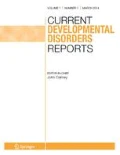Abstract
Regular engagement in physical activity is one of the most powerful predictors of health. Individuals with intellectual disabilities engage in significantly less physical activity than the general population and experience significant health disparities. More research is required to quantify the appropriate amount of physical activity that is necessary for health, as well as how to accurately collect, analyze, and interpret physical activity data on people with intellectual disabilities. Physical activity promotion efforts are especially important in this sub-group of the population due to the far reaching benefits. More research is also needed on the most effective avenues and messaging to promote physical activity in individuals with disabilities.
Similar content being viewed by others
References
U.S. Department of Health and Human Services. Physical activity and health: a report of the Surgeon General, U.S. Department of Health and Human Services, National Center for Chronic Disease Prevention and Health Promotion, Editor. Atlanta, GA; 1996.
World Health Organization, Global recommendations on physical activity for health. World Health Organization, 2010.
U.S. Department of Health and Human Services. Healthy people 2010: understanding and improving health. 2nd ed. Washington, DC, 2000.
U.S. Department of Health and Human Services. Closing the gap: a national blueprint for improving the health of individuals with mental retardation. Surgeon General’s conference on health disparities and mental retardation. Rockville: Office of Surgeon General; 2002.
Janssen I, Leblanc AG. Systematic review of the health benefits of physical activity and fitness in school-aged children and youth. Int J Behav Nutr Phys Act. 2010;7:40.
Tremblay MS et al. Systematic review of sedentary behaviour and health indicators in school-aged children and youth. Int J Behav Nutr Phys Act. 2011;8:98.
Lunsky Y, Klein-Geltink J, Yates E. Atlas on the primary care of adults with developmental disabilities in Ontario. Institute for clinical evaluative sciences and centre for addiction and mental health: Toronto, ON, 2013
Krahn GL, Hammond L, Turner A. A cascade of disparities: health and health care access for people with intellectual disabilities. Ment Retard Dev D R. 2006;12(1):70–82.
Cooper RA et al. Research on physical activity and health among people with disabilities: a consensus statement. J Rehabil Res Dev. 1999;36(2):142.
Foley JT, Lloyd M, Temple VA. Body mass index trends among adult U.S. Special Olympians, 2005–2010. Adapt Phys Activ Q. 2013;30(4):373–86.
Lloyd M, Foley JT, Temple VA. Body mass index of children and youth with an intellectual disability by country economic status. Prev Med. 2014;69C:197–201.
Temple VA, Foley JT, Lloyd M. Body mass index of adults with intellectual disability participating in Special Olympics by world region. J Intel Disabil Res. 2013. doi:10.1111/jir.12011.
Frey GC, Stanish HI, Temple VA. Physical activity of youth with intellectual disability: review and research agenda. Adapt Phys Activ Q. 2008;25(2):95–117.
Temple VA. Barriers, enjoyment, and preference for physical activity among adults with intellectual disability. Int J Rehab Res. 2007;30(4):281–7.
Temple VA, Frey GC, Stanish HI. Physical activity of adults with mental retardation: review and research needs. Am J Health Promot. 2006;21(1):2–12.
Hinckson EA, Curtis A. Measuring physical activity in children and youth living with intellectual disabilities: a systematic review. Res Dev Disabil. 2013;34(1):72–86.
Tremblay MS et al. Process description and evaluation of Canadian physical activity guidelines development. Int J Behav Nutr Phys Act. 2010;7:42.
Timmons BW et al. Systematic review of physical activity and health in the early years (aged 0–4 years). Appl Physiol Nutr Metab. 2012;37(4):773–92.
Warburton DE et al. A systematic review of the evidence for Canada’s physical activity guidelines for adults. Int J Behav Nutr Phys Act. 2010;7:39.
Paterson DH, Warburton DE. Physical activity and functional limitations in older adults: a systematic review related to Canada’s physical activity guidelines. Int J Behav Nutr Phys Act. 2010;7:38.
Martin Ginis KA et al. The development of evidence-informed physical activity guidelines for adults with spinal cord injury. Spinal Cord. 2011;49(11):1088–96.
Latimer-Cheung AE et al. Development of evidence-informed physical activity guidelines for adults with multiple sclerosis. Arch Phys Med Rehabil. 2013;94(9):1829–1836 e7.
Temple VA, Stanish HI. Pedometer-measured physical activity of adults with intellectual disability: predicting weekly step counts. Am J Intellect Dev Disabil. 2009;114(1):15–22.
Colley RC, Janssen I, Tremblay MS. Daily step target to measure adherence to physical activity guidelines in children. Med Sci Sports Exerc. 2012;44(5):977–82.
Matthews L et al. Agreement of accelerometer and a physical activity questionnaire in adults with intellectual disabilities. Prev Med. 2011;52(5):361–4.
Murphy NA, Carbone PS. Promoting the participation of children with disabilities in sports, recreation, and physical activities. Pediatrics. 2008;121(5):1057–61.
Bremer E, Crozier M, Lloyd M. A systematic review of the behavioural outcomes following exercise interventions for children and youth with autism spectrum disorder. Autism 2016: p. 1–17.
Lubans DR et al. Fundamental movement skills in children and adolescents: review of associated health benefits. Sports Med. 2010;40(12):1019–35.
Lloyd M et al. Long-term importance of fundamental motor skills: a 20-year follow-up study. Adapt Phys Activ Q. 2014;31(1):67–78.
Palisano RJ et al. Gross motor function of children with Down syndrome: creation of motor growth curves. Arch Phys Med Rehabil. 2001;82(4):494–500.
Lloyd M, Macdonald M, Lord C. Motor skills of toddlers with autism spectrum disorders. Autism, 2011.
Bremer E, Balogh R, Lloyd M. Effectiveness of a fundamental motor skill intervention for 4-year-old children with autism spectrum disorder: a pilot study. Autism, 2014.
Block ME. Motor development in children with Down syndrome: a review of the literature. Adapt Phys Activ Q. 1991;8:179.
Ulrich DA et al. Physical activity benefits of learning to ride a two-wheel bicycle for children with Down syndrome: a randomized trial. Phys Ther. 2011;91(10):1463–77.
Special Olympics International, 2012 reach report. 2012, Special Olympics International.
Author information
Authors and Affiliations
Corresponding author
Ethics declarations
Conflict of Interest
Meghann Lloyd declares that she has no conflict of interest.
Human and Animal Rights and Informed Consent
This article does not contain any studies with human or animal subjects performed by any of the authors.
Rights and permissions
About this article
Cite this article
Lloyd, M. Physical Activity of Individuals with Intellectual Disabilities: Challenges and Future Directions. Curr Dev Disord Rep 3, 91–93 (2016). https://doi.org/10.1007/s40474-016-0079-5
Published:
Issue Date:
DOI: https://doi.org/10.1007/s40474-016-0079-5




